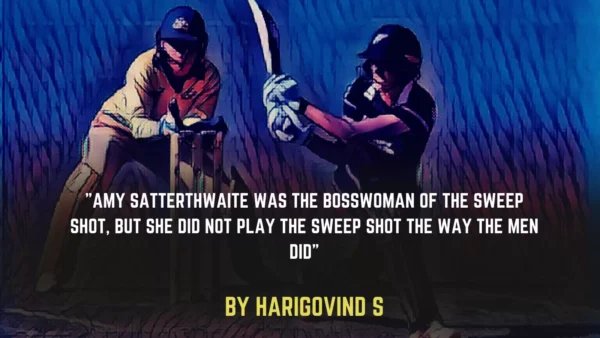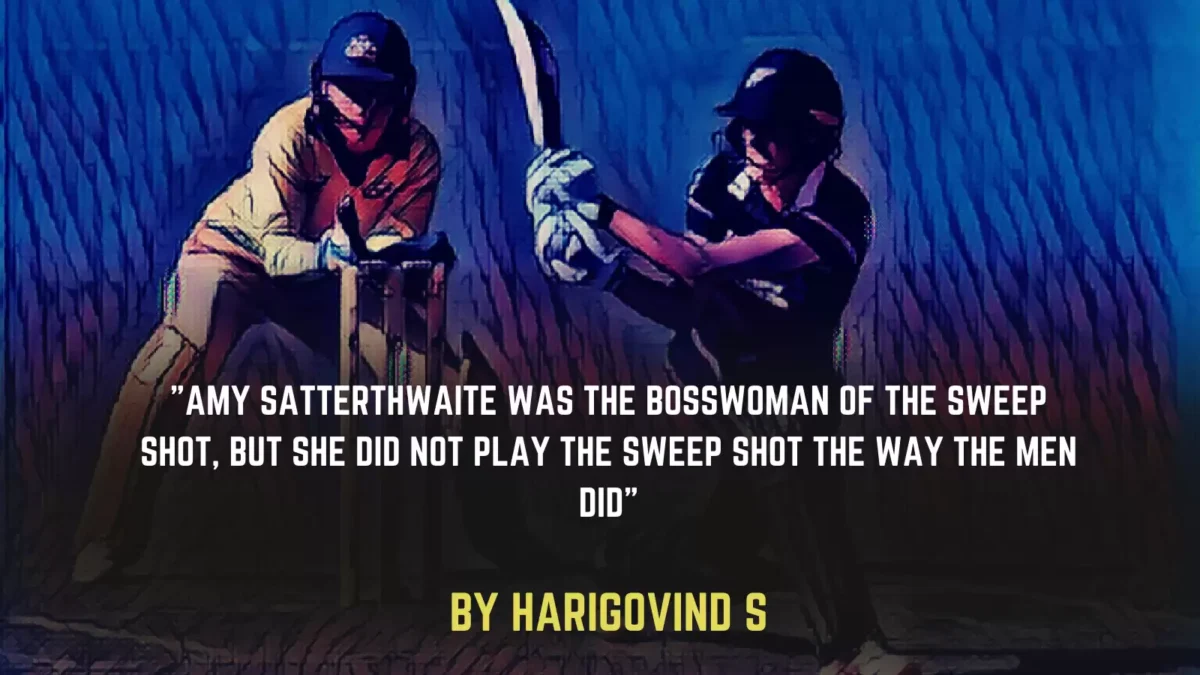
Amy Satterthwaite was the bosswoman of the sweep shot, but here's why it is important.

Amy Satterthwaite was a great sweeper.
The sweep shot is the bridge between the past and the present of cricket; the only “textbook” shot that is a wilful embrace of brute power. Sure, the cuts and the pulls may shake their heads, but the hitter’s power position is not located on the back leg.
Research in biomechanics informs us that one of the key variables predicting power-hitting range in cricket is the extension of the lead elbow during bat-ball contact (here is a whole ass article about this) and this is precisely what the sweep shot does. As the BBC Sport Academy advises, you have to “bend the front leg and collapse the back leg … and strike the ball in front of the pad with the arms outstretched.”
And the sweep shot is important to women’s cricket because at lower speeds of bowling you must intercept the ball early to make pace off the wicket.
And Amy Satterthwaite was the bosswoman of the sweep shot.
In a game in which the checked drive ceased to be the shot offered only when the players’ non-playing livelihoods were threatened, it was a shot that lay halfway between textbook and torpedo that shaped much of the game. Because of low pace and high spin, batters swept more. Because they swept more, bowlers bowled wider lines.
Amy Satterthwaite wore this shot like it was the royal gown she wore to every game of cricket she played. So much so that she did not just dash down the pitch when the Melbourne Renegades needed six off the last ball to force a super over in the 2017-18 WBBL, she also unfurled the slog sweep. That is crazy commitment to a shot.
Yet, like all the greats of this world whose anomalousness flows in some way from the definition of the word “great” itself, she too had a quirk.
She did not play the sweep shot the way the men did.
To show various exhibits of her sweep shot so that we may glean biomechanical aspects of its style is needlessly tedious, so I made a choice that does not fully eliminate the subjectivity involved in such analysis but also gives us the best chance of studying the stroke. Above is a side-on frame of her sweep at the point of bat-ball contact. We use this as the median of all her sweep shots in the final few months of her career.
The BBC Sport Academy’s recommendations for playing the sweep shot are unambiguous: Maintain full extension of the top hand during bat-ball contact, and collapse the back leg to get low in stature to wipe the ball off the surface.
Amy Satterthwaite did neither of that.
Buses would still be in business in Long Island if the low-hanging overbridges built by Robert Moses were made of Amy Satterthwaite. Because she never got down low enough to sweep the ball. If the sweep of Satterthwaite were an armoury rifle, it would be the sniper, not the pistol. For she never extended the leading arm during bat-ball contact. Satterthwaite’s sweep was more polishing the pedestal rather than the pitch, a dubious cross between a poorly executed paddle and a flick shot played by the tallest batter on earth. If it were a sleeping style, it would be sleeping on the work desk, not the bed.
Such was Satterthwaite that she didn’t hunker down to the pitch like the office napper or “strike the ball in front of the pad with the arms outstretched.” Yet, she was one of the finest sweepers in the game. It was altogether weird.
Part of it makes sense. In fact, it makes sense that women don’t do any kind of action the way men do them. Because women’s fundamental anatomies are different. You may think that this difference is limited to changes in bone density and muscle mass, but it is more. Women face what is called femoral anteversion and external tibial torsion, which is another way of saying that their thighs and knees are inwardly twisted and their feet are outwardly turned. Things like this are perhaps why women pitchers in baseball display greater flexion of their hips and knees, and some evidence in cricket fast bowlers also points to the same. It is a possibility indeed that the different biologies of men and women cause the shot mechanics that are ideal for women to be different from those which are ideal for men, maybe Satterthwaite and other female sweepers don’t collapse their back knees because that is better for them.
But is it true indeed that most women play the sweep shot this way? Or was Satterthwaite the exception to the norm, a swirling wave beating against a current of forward-swimming fish?
Cricket is not yet at that stage where you can have retroreflective markers pinned to players as they take the field, so I sat down to collect side-on angles of the myriad sweepers of the 2022 women’s T20 Challenge.
Half of what I found were Harmanpreet Kaur herself, a windscreen wiper that made 47% of her runs in her 71 against Velocity through the sweep. If we ignore her on account of her otherworldliness, then every batter in the remaining exhibits shows either one or both of the same traits that Satterthwaite did, flexion of the lead elbow and a non-collapsed back leg. There’s also the possibility that this could be a biased sample set because side-on angles are displayed on TV mostly for boundary hits, which could just be the well-hit sweeps. Put these together, and we may confirm that women sweepers do on average break the coaching law.
(A median exhibit of the sweep shot bar Harmanpreet Kaur)
It is true that the likes of Harmanpreet, Alyssa Healy and Sophia Dunkley are leading women’s cricket’s favourite shot in the direction of what it is in the men’s game, but a massive chunk of women still do play it the Satterthwaite way. And we cannot dismiss them as just ordinary players with ordinary mechanics because we know that the biologies of men and women differ, a difference that could potentially bear upon on their hitting mechanics. Are we just to accord these to the non-eliteness of Priya Punia, Hayley Matthews and Tania Bhatia?
Either it is the case that most elite female cricketers are playing it the wrong way because of lack of elite coaching or talent or research, or it is the case that the vast biological difference between men and women implies that the elite shot mechanics of a woman’s differ from men’s.
And frankly, we simply do not know. The farthest the biomechanics of cricket has gone to studying women’s power-hitting is McErlain-Naylor et al’s excellent paper which confirms that skilled female hitters do display lower levels of forearm extension during bat-ball contact, lower levels of hip-shoulder separation at downswing initiation and wrist uncocking while hitting the cricket ball. These same variables were revealed to contribute to 78% of hitting success in a landmark study by Peploe and team on England men’s internationals.
But we do not yet know whether lower levels of forearm extension and hip-shoulder separations contribute to greater hitting range in women or not, because an “elite” subgroup was not part of the study. The farthest the experiment reveals is that women power-hitters do exhibit less of what is considered good for men strikers, but what if that which is good for the men is not good enough for the women?
Perhaps, women are employing the technique traditionally used for the checked drive, causing them to flex their leading arms at work. Perhaps, women suffer from an anticipatory disadvantage because of lower levels of coaching or practice. We simply do not know. But it does bring to light the fact that just like we cannot have the data to confirm that Amy Satterthwaite was the most prolific sweeper of her times, we also do not have the research to say definitively that women hitters must use different hitting strategies compared to men to achieve greatness.
In 2018, Catherine Munro and Candice Christie searched the Ebscohost, Science Direct, Scopus, PubMed, and Google Scholar databases for studies pertaining to women’s cricket. They found nine. If cricket is a male sport, the science of cricket is as much a male science too. Nor is this a characteristic of just cricket: “As experienced practitioners would attest,” writes Sophia Nimphius of Softball Australia, “knowing the gender of the athlete provides much less information than knowing his or her training status (eg, no resistance training) or motor skills (eg, competent running mechanics). Then, why do we allow many studies to conclude something to the effect of ‘therefore females have different landing mechanics?’”
Basically, lots of studies exist in sports that confirm that women have different mechanics compared to men. But none have studied whether these different mechanics are tailored to suit the different physiologies of women or are the products of inferior coaching, inferior skill, or inferior attunement, because not enough people have cared. The best we have is evidence in golf that the best in the business do extend their forearms during contact. And when it comes to batting in cricket, there are fewer studies of the first kind than there are icebergs in the Mediterranean. That the closest there is to understanding whether these differences are the result of distinct anatomies or resource unavailability is a sham journalistic article that shows that Harmanpreet Kaur exhibits more elbow extension than the lesser mortals of the women’s T20 Challenge is all you need to know.
The most we can say, then, is that Amy Satterthwaite was the beacon of a certain style of sweeping unseen in men’s cricket but found in great concentrations in the women’s sport, and that Harmanpreet is the lighthouse of the new. Did she make it work because she was taller than the average woman? Or was it skill, talent, magic – the set of all intangibles that we scrounge when we cannot find answers? In an age of scant research, scant data equipment, and non-existent money, Satterthwaite took cricket’s most unorthodox textbook shot and made it even more unorthodox. And she made it work like that. Just like she did everything else.